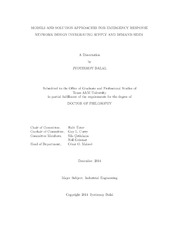| dc.description.abstract | We present three models for emergency response network design. First, in a deterministic setting, we focus on two critical aspects of emergency logistics: evacuation and relief distribution. We consider a three-tier system comprising evacuation sources, shelters, and distribution centers (DC). Applying a multi-objective mixed integer programming model, we minimize the evacuees’ maximum travel distance and total system cost. To solve large scale instances, we implement Benders Decomposition (BD) with callback feature, solving the master problem only once, thereby, saving significant solution time. We also find that tuning of master tree search parameters along with strengthening of the Benders cuts, impact convergence significantly. Next, our model is applied to a GIS-based case study on coastal Texas. We find the effects of changing problem parameters and explain the cost vs. critical distance trade-offs. We conclude that our proposed system works better than the system in practice by comparing them and by providing interesting managerial insights on location decision.
In the second study, for a more detailed network comprising five tiers and multiple modes of transport, we determine the centralized supply locations that serve the region under consideration under any disaster event. Using scenario and interval based representations together, we address uncertainties (1) in disaster location, intensity, and duration, and (2) in demand due to varied compliance rate of the population to the authority’s orders. We efficiently solve the large scale instances using a decomposition-based approach. The model is applied to a case study on the Gulf coast of the USA. We find the effects of population density and disaster intensity on location-allocation decisions. Our model captures the trade-offs between system cost and critical time to start relief distribution, and can aid an emergency manager in strategic decision making under various uncertainties.
Our third study combines the stochastic and robust optimization concepts. Disaster intensity and location related uncertainties are represented by a discrete scenario set. In a problem setting similar to our first study, the DC and shelter opening costs, and the weighted sum of the worst case (robust optimization) and expected (stochastic optimization) flow costs are minimized over all scenarios. We present Benders Decomposition based solution approaches to solve the model with different relative weight vectors. We conduct a case study on coastal Texas and observe the effects of changing certain problem parameters. We find that the underlying demand pattern dictates whether placing the relative emphasis on worst and average cases would alter the location decisions. Our model allows the decision maker to explore several alternatives by changing the emphasis on worst vs. average case cost minimization. | en |


